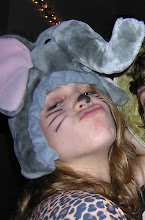from my high school literary magazine, my favorite poem, written by Grace Wampler, a fifteen year-old girl:
"Pink and Kyle"
My purse is pink, which makes me happy
My boyfriend's name is Kyle; he makes me happy as well
My room used to be pink
Not many people I know are named Kyle
Sometimes I wish I could spray-paint things pink
It'd be weird if you could spray-paint things Kyle
Sarah and I wish we would have tennis raquets which are pink
Hopefully this weekend I'll see Kyle
Lydia loves pink
My dog loves Kyle
I have roses that are pink
I probably shouldn't give girly flowers to Kyle
Mal and Sara love pink
Diesel and Puma love Kyle
Monday, March 5, 2007
dan flavin
Dan Flavin considered himself an American Minimalist sculptor, though I feel that he falls under the category of "light artist" more than anything. His work with light started with what he called "icons" - series of painted canvases highlighted with halogen light fixtures. If I had the money to buy halogen tubes, I would've tried to combine something like his work with chromotherapy. But anyway, I really love the idea of being overwhelmed by color and light, and I imagine seeing his works in person would often be very overwhelming.


inspiration for a justin timberlake video?:




inspiration for a justin timberlake video?:


Sunday, March 4, 2007
explosions in the sky
As many of you know, I'm from Louisville, KY. What you probably don't know is that Louisville, KY is home to the largest annual fireworks display in the nation (wikipedia agrees) called Thunder Over Louisville, which kicks off the Kentucky Derby festival. Several hundred thousand people attend the event - more than four times the number who go to the actual Derby.
I wanted to show a video of it, but none of the videos on YouTube did it justice. It's a really gorgeous event - thirty minutes of fireworks exploding from gigantic river barges and two bridges that cross the Ohio River. It also didn't exactly capture the sentiment of the event - everyone comes early in the day (usually in bad weather), watches the Air Force Thunderbirds and eats fried deliciousness, starts getting anxious for the fireworks to start, then leaves halfway through the fireworks in order to beat everyone else, who had the same idea. Oh, Kentucky.




I wanted to show a video of it, but none of the videos on YouTube did it justice. It's a really gorgeous event - thirty minutes of fireworks exploding from gigantic river barges and two bridges that cross the Ohio River. It also didn't exactly capture the sentiment of the event - everyone comes early in the day (usually in bad weather), watches the Air Force Thunderbirds and eats fried deliciousness, starts getting anxious for the fireworks to start, then leaves halfway through the fireworks in order to beat everyone else, who had the same idea. Oh, Kentucky.



Thursday, March 1, 2007
color therapy

... or as it is alternatively known, "Chromotherapy," is the idea that you can balance out your chakras by exposing yourself to a certain color or light in a particular area of your body.
Red: Base of the spine
Affects blood disorders, energy depletions, and bone marrow. People who have excess red energy can be stubborn.
Orange: Pelvis
Stands for kind-heartedness, alertness
Yellow: Just above the belly button
Creates an impression of detachment and liberation. Applied when trying to cure lymphatic diseases.
Green: Heart
Associated with a harmonizing effect. Considered to be the color of concentration, used to cure bronchitis and the whooping cough, but a person with excess green energy can be lethargic and unmotivated.
Blue: Throat
Color of peace and infinity (how original). It is said to have a positive effect on all sorts of pain, but an excess of blue could be melancholic. They're blue, literally.
Indigo: Lower forehead
Supposed to develop psychic perception and intuition, used to treat addiction and to control bleeding.
Violet: Top of the head
Considered to be a meditative color, used to calm the nervous system.
Honestly, I'm not sure how I feel about all this, but I'd be really interested in any research that has been done on how color affects people. I do feel emotions when I'm overwhelmed by a certain color, but curing diseases? Interesting thoughts.
Tuesday, February 20, 2007
nailpolish
My mom says that her dream job is to be the person who names the nailpolish colors for OPI. Honestly, I can't blame her. For example,

"That's All Bright With Me!"

"Can't You Sea?"

"Hey! Get In Lime!"
And so on. According to wikipedia, the color and condition of a person's nails were indicators of their social status. Ancient Chinese used a mix of gum, egg whites, gelatin, and beeswax to paint their nails; today, nail polish is made with nitrocellulose dissolved in a solvent with added pigment. Ruby red nails were signs of royalty in ancient Egypt. Supposedly, Uma Thurman brought back dark red nailpolish by wearing it in Pulp Fiction ("Vamp" by Chanel).


I'm inspired.

"That's All Bright With Me!"

"Can't You Sea?"

"Hey! Get In Lime!"
And so on. According to wikipedia, the color and condition of a person's nails were indicators of their social status. Ancient Chinese used a mix of gum, egg whites, gelatin, and beeswax to paint their nails; today, nail polish is made with nitrocellulose dissolved in a solvent with added pigment. Ruby red nails were signs of royalty in ancient Egypt. Supposedly, Uma Thurman brought back dark red nailpolish by wearing it in Pulp Fiction ("Vamp" by Chanel).


I'm inspired.
Friday, February 16, 2007
holy holy holy
it blows my mind that things can be 759 years old, namely, the church of Sainte-Chapelle in Paris, home to some of the most beautiful stained glass windows in the world. It was built to house the relics of Christ's crown of thorns, and has been called the jewelry box of Paris because of its dainty size and delicate features. I've been there - it's gorgeous, and not entirely overwhelming like Notre Dame and Sacre Coeur.
There's a replica of the church in Chicago. Does that cheapen the original...?
Anyway, pictures:

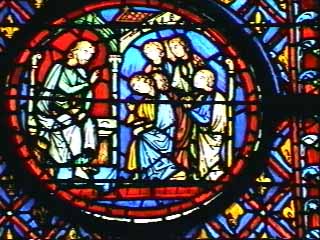

There's a replica of the church in Chicago. Does that cheapen the original...?
Anyway, pictures:



Tuesday, February 6, 2007
cliche, cliche monet
Whenever art historians talk about revolutionary use of light in painting, you usually hear Monet's name thrown around. I'm no exception - and I'm a sucker for his work. I really love his series of the Rouen cathedral and the haystacks... the repetition is almost hypnotic. He knew that every moment, the light changed, and his painting needed to change with the light, so he worked on several paintings simultaneously. We get the cathedral in the morning, noon, afternoon; the haystacks in the snow, in twilight... Same image, different light. Amazing, hm?
Cathedrals
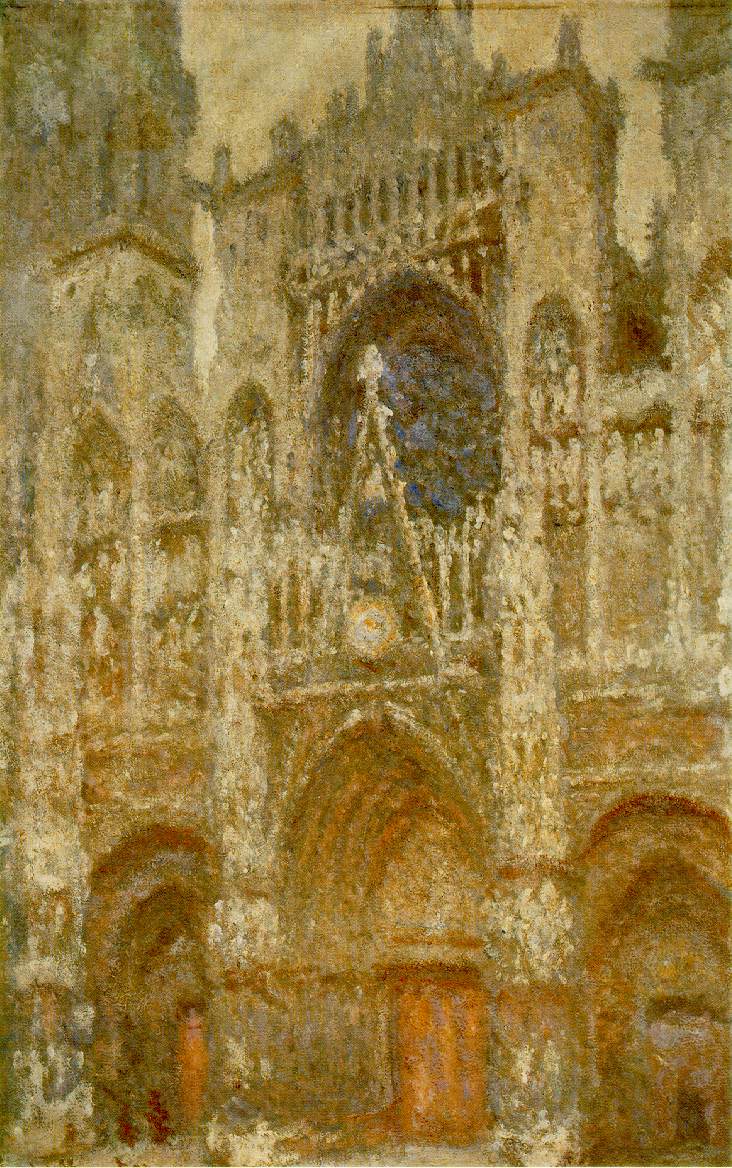


Haystacks
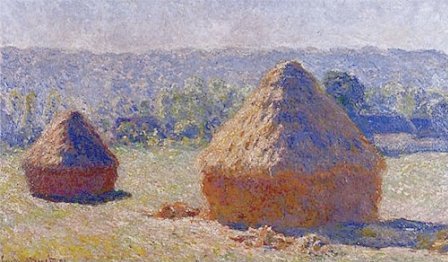

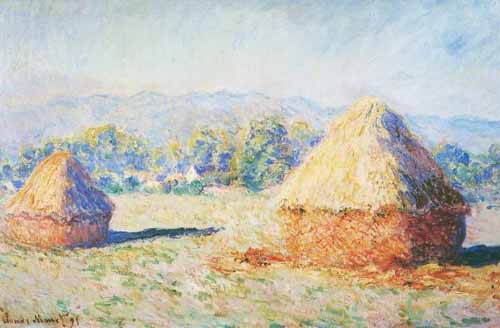
Cathedrals



Haystacks



Monday, January 29, 2007
donald judd - individual light artist project
My focus for this archive is color as it relates to light, and the artist I'm focusing on today is Donald Judd. I stumbled across Donald Judd at the MoMA this summer - on a tangent note, I have a huge crush on the MoMA; all of my postcards in my room (see below) are from there. Anyway, Donald Judd considered materiality to be the central part of his work, and I think that theme works well with both color and light. For example, the color and reflections of this sculpture depend entirely on the color-infused plexiglass that he used to create it:

Judd worked mostly from plexiglass like this, wood, metal, plywood, and concrete.

(He used metal for this one)
Later in his career, he grew more and more dissatisfied with the art world - specifically, the idea of temporary exhibits designed by snobby curators. He created permanent installations that were not meant to represent anything.
In 1986, the Chinati foundation opened a non-profit art center in Marfa, TX, for Judd and his contemporaries, like Dan Flavin and Claes Oldenberg (below). Judd contributed 15 outdoor pieces and 100 aluminum pieces to the permanent collection. Sadly, Judd died in 1994 of lymphoma in Manhattan.
But on a happier note: Color! Material! Light! Minimalism!



And just because these other guys are cool too...

Dan Flavin

Claus Oldenburg

Judd worked mostly from plexiglass like this, wood, metal, plywood, and concrete.

(He used metal for this one)
Later in his career, he grew more and more dissatisfied with the art world - specifically, the idea of temporary exhibits designed by snobby curators. He created permanent installations that were not meant to represent anything.
In 1986, the Chinati foundation opened a non-profit art center in Marfa, TX, for Judd and his contemporaries, like Dan Flavin and Claes Oldenberg (below). Judd contributed 15 outdoor pieces and 100 aluminum pieces to the permanent collection. Sadly, Judd died in 1994 of lymphoma in Manhattan.
But on a happier note: Color! Material! Light! Minimalism!



And just because these other guys are cool too...

Dan Flavin

Claus Oldenburg
Saturday, January 27, 2007
Thursday, January 25, 2007
cross-referencing classes
In my Film Studies class, we're learning about how early film strips were tinted, toned, and hand-painted to create various color effects. I'm sure the photography people in the class know all about this, but I think it's really interesting, and especially relevant to light.
From "Cenere", an example of film toning

From "The Cabinet of Dr. Caligari," an example of tinting

From "The Wizard of Oz," a classic example of Technicolor - famous for rich, saturated color

From "Cenere", an example of film toning

From "The Cabinet of Dr. Caligari," an example of tinting

From "The Wizard of Oz," a classic example of Technicolor - famous for rich, saturated color

Saturday, January 20, 2007
Let the archiving begin!


For my Sculpture 1 archive project, I'm going to be collecting color - in works of art, movies, songs, anything! Because this class is supposed to be about light as a sculptural object, I'm going to try and find particularly luminous colors and colored lights, etc. I really feel that color can affect our emotions very strongly in ways that we probably don't realize. I should also probably do some research into how color and light work together - I know that color would not exist without light, but how exactly does light bounce off color and register in our eyes? All to be discovered. Anyway, I'm an art history major with a focus on modern art, and I think that anyone who walks into my room (pictures on the left) can see how much I love art, and color especially.
One more thing - this is my latest favorite commercial. Most of you all have probably seen the Bravia advertisement with the bouncy balls in San Francisco, and this is along the same lines - made with real paint.
Subscribe to:
Comments (Atom)


